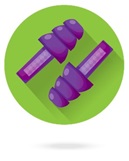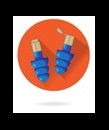Passive hearing protection can do more than protect from hazardous noise levels. When selecting devices, the hearing protection devices (HPDs) should
- Provide adequate protection against noise;
- Be comfortable for the person to wear; and
- Allow the wearer to hear critical sounds.
The descriptions below provide information on the various types of passive hearing protection. For questions on which device is most appropriate, consult with your Hearing Conservation Program manager, an audiologist, industrial hygienist/bioenvironmental engineer, or safety officer.
 Disposable foam earplugs are widely available and can have the highest level of noise protection.
Disposable foam earplugs are widely available and can have the highest level of noise protection.
Advantages of disposable earplugs:
- High levels of noise attenuation
- Noise attenuation refers to the amount of sound being blocked or reduced.Higher levels of attenuation means more sound prevented from reaching noise sensitive areas of the ear
- Comfortable for extended wear
- Inexpensive
- Multiple sizes available
Disadvantages:
- Difficult to consistently fit resulting in lower levels of attenuation
- People wearing these devices may think they are achieving adequate protection but improper insertion can decrease the amount of attenuation
- One size does not fit all
- Extra training to insert properly and consistently
- Takes extra time to insert if going in and out of noise environments
 Preformed or pre-molded earplugs provide a consistent fit and are reusable. They come in different sizes. Trained technicians at hearing conservation clinics can fit service members and civilians with the right size.
Preformed or pre-molded earplugs provide a consistent fit and are reusable. They come in different sizes. Trained technicians at hearing conservation clinics can fit service members and civilians with the right size.
Advantages:
- Reusable
- Washable with warm soapy water
- Provide consistent fit
- Multiple sizes
- Comfortable when sized and fitted correctly
- Provide good levels of noise attenuation when fitted and inserted properly
- Economical for people who work in consistent noise hazardous environments
- Easy to insert if going in and out of noise environments
Disadvantages:
- Correct sizing is critical
- Becomes loose from jaw movements such as talking or chewing or a slight bum to the earplug
 Filtered earplugs preserve sound quality. They are great for musicians as they reduce noise, lowering the volume, while not affecting sound quality. Filtered earplugs are also known as flat attenuation, linear attenuation, uniform attenuation, or musician’s earplugs. The names reflect how the earplug reduces noise equally across frequencies. Sounds are more natural sounding with an added benefit of protecting hearing.
Filtered earplugs preserve sound quality. They are great for musicians as they reduce noise, lowering the volume, while not affecting sound quality. Filtered earplugs are also known as flat attenuation, linear attenuation, uniform attenuation, or musician’s earplugs. The names reflect how the earplug reduces noise equally across frequencies. Sounds are more natural sounding with an added benefit of protecting hearing.
Advantages:
- Preserve sound quality
- Low attenuation levels enable people to hear critical sounds easier
Disadvantages:
- Correct sizing is critical
- Not suitable for higher noise environments
- Becomes loose from jaw movements such as talking or chewing or a slight bump to the earplug
 Level-dependent earplugs are passive earplugs that block sounds in either a closed (shown on left) or open (shown on right) position. Level-dependent earplugs are designed for a tactical environment. A ground troop can use these devices in a closed position when riding in a transport vehicle, protecting them from the continuous noise. While on the ground as part of a foot patrol, the same devices can be worn in the open position preserving the ability to listen for critical sounds and still protecting the individuals from sudden impulsive noise.
Level-dependent earplugs are passive earplugs that block sounds in either a closed (shown on left) or open (shown on right) position. Level-dependent earplugs are designed for a tactical environment. A ground troop can use these devices in a closed position when riding in a transport vehicle, protecting them from the continuous noise. While on the ground as part of a foot patrol, the same devices can be worn in the open position preserving the ability to listen for critical sounds and still protecting the individuals from sudden impulsive noise.
Level-dependent earplugs are also known as nonlinear earplugs, amplitude-sensitive earplugs, tactical earplugs,
shooter’s earplugs, and vented earplug
Advantages:
- Critical sounds can be heard while protecting your ears from damaging impulsive noise
- Two positions – open and closed
- Closed for continuous noise
- Open for impulsive noise
Disadvantages:
The open position offers little protection against continuous noise
- Correct sizing is critical
- Closed position impairs ability to hear critical sounds
- Becomes loose from jaw movements such as talking or chewing or a slight bump to the earplug
 Ear muffs, provide good protection from continuous noise environments. They are easy to put on and take off so are great for intermittent noise exposure. Because they cover the pinna or the outer ear, determining the direction of a sound is more difficult. Most ear muffs have a correct way to wear them. The headband should fit snugly over the top of your head. A loose headband will cause the earcups to slide and not provide a proper seal. To get a good seal around the earcups, the material must be pliable, undamaged, and properly sized. Some ear muffs are available in multiple sizes even for small children. When worn improperly, the ear muffs will block less noise and not provide the expected protection.
Ear muffs, provide good protection from continuous noise environments. They are easy to put on and take off so are great for intermittent noise exposure. Because they cover the pinna or the outer ear, determining the direction of a sound is more difficult. Most ear muffs have a correct way to wear them. The headband should fit snugly over the top of your head. A loose headband will cause the earcups to slide and not provide a proper seal. To get a good seal around the earcups, the material must be pliable, undamaged, and properly sized. Some ear muffs are available in multiple sizes even for small children. When worn improperly, the ear muffs will block less noise and not provide the expected protection.
Advantages:
- Easy to don and doff, making them good for intermittent noise exposure
Disadvantages:
- Cues to localizing sounds are blocked by ear muffs